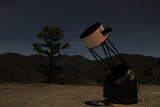A help for people who do not speak English well
The languages spoken during the workshop are English and/or Spanish. Even if sometimes one of the instructors masters other languages, it is generally not possible for us to make a systematic translation in other languages for time reasons.
Nevertheless, with this document, you will be able to actively participate in the workshop we offer. Maybe someone, or an online translator can help you to understand it.
At the agreed time a vehicle will pick you up in front of your hotel or residence. We do not know our destination for tonight yet and if the sky gets cloudy the workshop may take long. Wherever we go, there will be no restrooms available. For this reason, you should go to the toilets before the pickup.
Your guide will give a short introduction about the program. He will talk about the weather conditions and the reason why we chose this day to do the excursion. The light of the moon when it is between half-moon and full moon, hinders us for the observation of the deep sky. But the clouds and the wind are much more disturbing, so the weather prevails, as far as possible.

A regional law in force in the Canary Islands obliges us to inform you about the risks of any activity to be carried out, and to have you sign a declaration of acceptance of these risks. Stargazing is not a specifically dangerous activity. Nevertheless we will of course respect the law. A leaflet will be distributed to you, in English, describing some of the risks. We would like to point out that the ground may not be completely flat and in the dark it is possible to fall to the ground. We invite you to stay close to the group. You may need to use a three-step ladder to raise yourself to the height of the eyepiece. Mosquitoes can bite you. There may be other risks that are unlikely and unpredictable. The document also indicates that we have a civil insurance for an amount of 1.5 million euros and an accident insurance without limits. The price of the activity is indicated (again). And we commit ourselves not to share your data with a third party. Please write your name and surname on the back and sign the document.
Transportation to the viewpoint of El Mulato. There we will take a break to take pictures of the impressive cliffs. After the pictures we will take stock again. It is usually the weather that decides our next destination. There are four possibilities:
1 - Presa del Mulato: we are relatively confident about the weather.
2 - Cruz de San Antonio: Something is bothering us. It is without a doubt that we see clouds on the Tauro mountain which is not a good sign at all even if the rest of the sky is clear. Sometimes, if the wind blows hard, we go to see if it blows less a little higher. It is rare, but it works from time to time.
3 - We go back and settle down near a big curve: The wind blows much too strong elsewhere, here we are protected.
4 - Other observation points: we have huge troubles with the clouds and we are doing our best.
Arrival at the observation point: The guide(s) will set up the telescope(s). It takes about 10 minutes. But if the clouds threaten, it only takes 5 minutes.
If you are cold, we have anoraks available, just ask us. We can also offer you a mosquito repellent. This is offered of course.
A brief description of the telescope is given. It is a reflecting telescope that uses two mirrors. The main mirror is large and has a parabolic shape. The parabola focuses the light rays to the focal plane. The distance between the parabolic mirror and the focal plane is the focal length of the telescope. The greater the focal length, the greater the magnification of the image. It is good to magnify the image. But due to the air movements of our atmosphere we can't magnify much more than 200 times. From 200 times, the image becomes blurred and if you continue to magnify you will lose the image completely.

We will use a telescope with a focal length of 1800 mm. This is a lot. It is not extreme either. Another characteristic of the telescope is its aperture. The aperture is the diameter of the main mirror. It is always the most important characteristic of a telescope because the aperture can not be replaced by any artifice. The larger the mirror, the more light the mirror collects from the stars, the brighter the image. We will use a telescope with an aperture of 16'' (40 cm). This is huge. That's why the telescope you are observing is big. That is why it is powerful. A bright image allows us to observe held objects.
Even if the moon is shining in the sky, we will invite you to observe deep sky objects with our telescope. It is more difficult if the conditions are not optimal but if we have called you tonight, it is because we believe that there is a way to observe deep sky objects (star clusters, galaxies, nebulae). The planets are always more or less observable if they are in the sky and if the weather conditions are good.
At the focal plane of the telescope, we adapt an eyepiece that allows us to observe. Like the telescope, the eyepiece has two important characteristics: the focal length and the field of view. Focal length: this time, the smaller it is, the bigger the image. We will use two focal lengths which with this telescope gives us two magnifications: 36 mm to magnify 50 times, 9 mm to magnify 200 times (we admit that the image is blurred since we are at the maximum allowed by the atmosphere of the earth). The other characteristic of the eyepiece is the field of view. This is the most important feature of the eyepiece. It is the total size of the image. We use the best eyepieces available on the market, with fields of view ranging from 70º to 100º. That's why, when we look at the moon, people often express an "oh" of admiration: we magnify it enough to see the details of the craters but the whole moon still fits in the field of view.
We have spoken enough. If the sky allows it and if sufficiently bright objects are visible (moon or planets) we begin the observation
If not, we have to wait until the sky is dark enough and observe deep sky objects. So we continue with a presentation with projector. Take your seats
The first slides show you the course of the workshop. Please note that at the end of the workshop we offer you the possibility to take a family picture with a long exposure. Do not move after the flash as the camera continues the exposure. This is often a nice souvenir photo of your vacation. The file needs some computer work (color adjustments, exposure etc.). We will send it to you as soon as possible (usually within a few days) to the email you used in the registration form. This is free of charge.

The following slides show you the constellations of the Big Dipper, the Little Dipper and the North Star. The Pole Star is in the axis of rotation of the earth, so it has no apparent movement. It is always in the same place in the sky (if you are in the northern hemisphere). The other stars give the impression that they are rotating around the Pole Star, because in reality we are the ones rotating in the opposite direction. If you return to the same place at any time, the North Star will be in the same place in the sky. Whether it is visible or not, day or night, winter or summer.
At the North Pole, the Earth's axis of rotation would be vertical and the North Star would be rightt above us. If we were on the equator, the North Star would be on the horizon. In short, the angle it makes with the horizon is our latitude. Here in the Canary Islands, the latitude is only 28º, and the North Star is relatively low on the horizon compared to northern Europe. All the better. After all, at the North Pole the sky only rotates around the zenith, so it is always the same sky that can be observed, whereas at the equator the whole celestial sphere is visible in pieces.
The following slides show you the sky for tonight. In red is the ecliptic plane, i.e. the plane of the solar system. This is where we can observe planets. This is also where we observe the constellations of the zodiac.
The following slides show you the deep sky objects that we have selected for you tonight. We show you where they are in the sky with the help of the constellations. We also show you how we can observe them using our equipment. Deep sky objects are never easy to observe. It is always useful to have seen them first in slides to recognize them more easily later. Three cases are provided: excellent observing conditions, average conditions and very bad conditions.
Once the projector presentation ends, we will show you the constellations we have mentioned in the sky. As well as the ecliptic plane and the planets if there are any.
Then we will continue with the observation of the deep sky.
Some parts of the workshop have been intentionally omitted in this document. They are simple and graphic enough to be understood without dominating the language that is spoken. And then it is necessary to leave some room for the unknown.
A word of advice though: pay close attention to the workshop's progress. The best is yet to come and none of the knowledge acquired will be superfluous to overcome the ordeal.
I wish you clear nights,
Gauthier